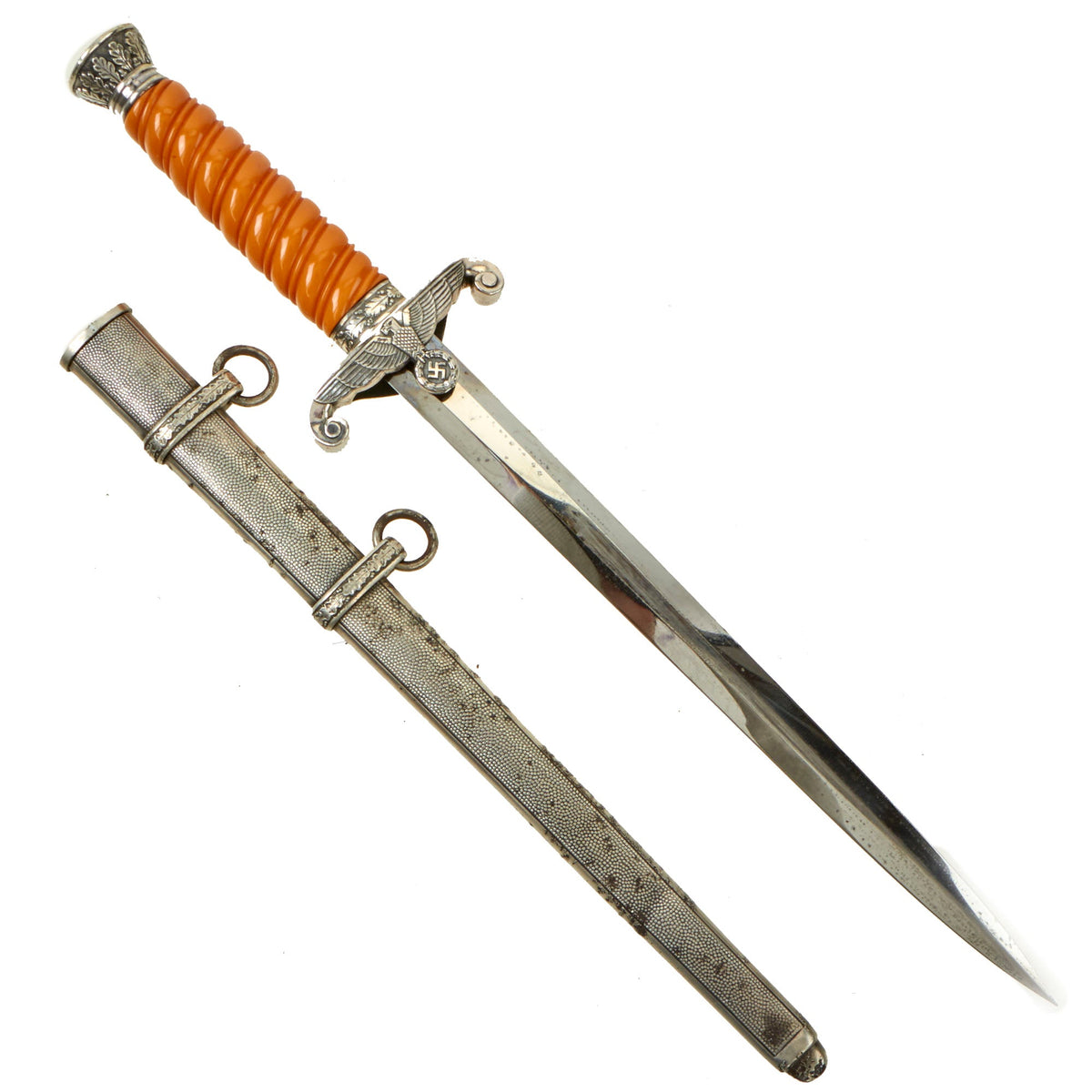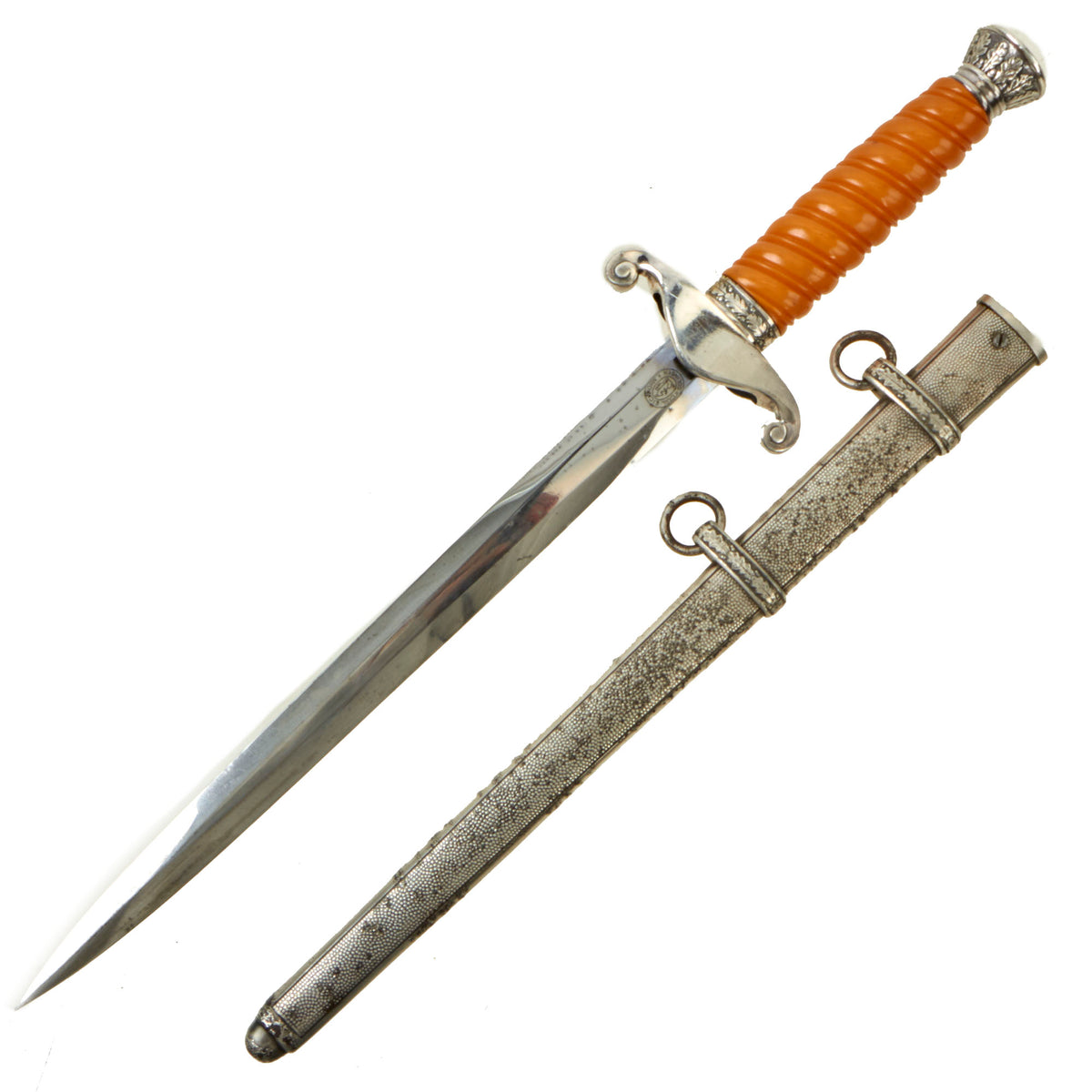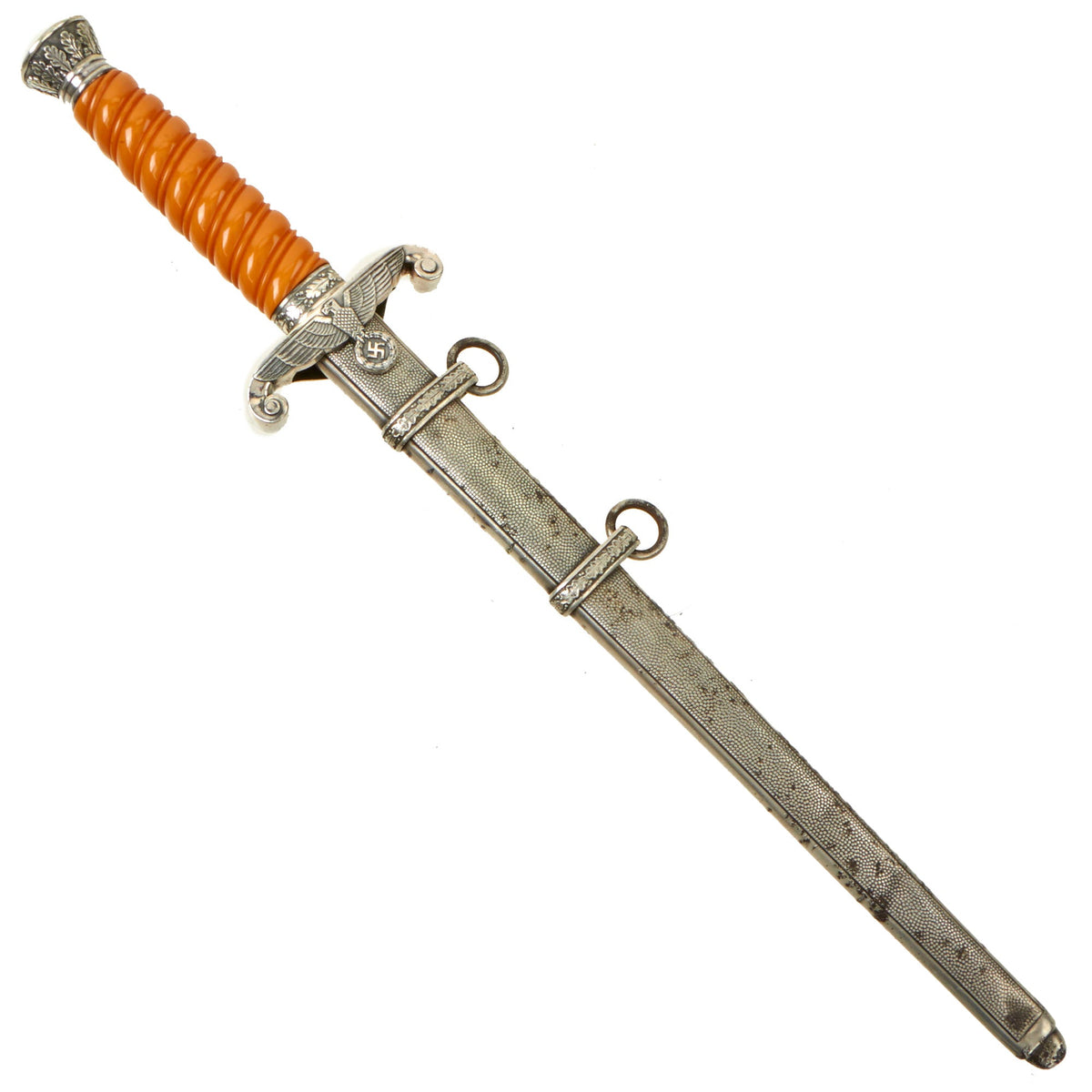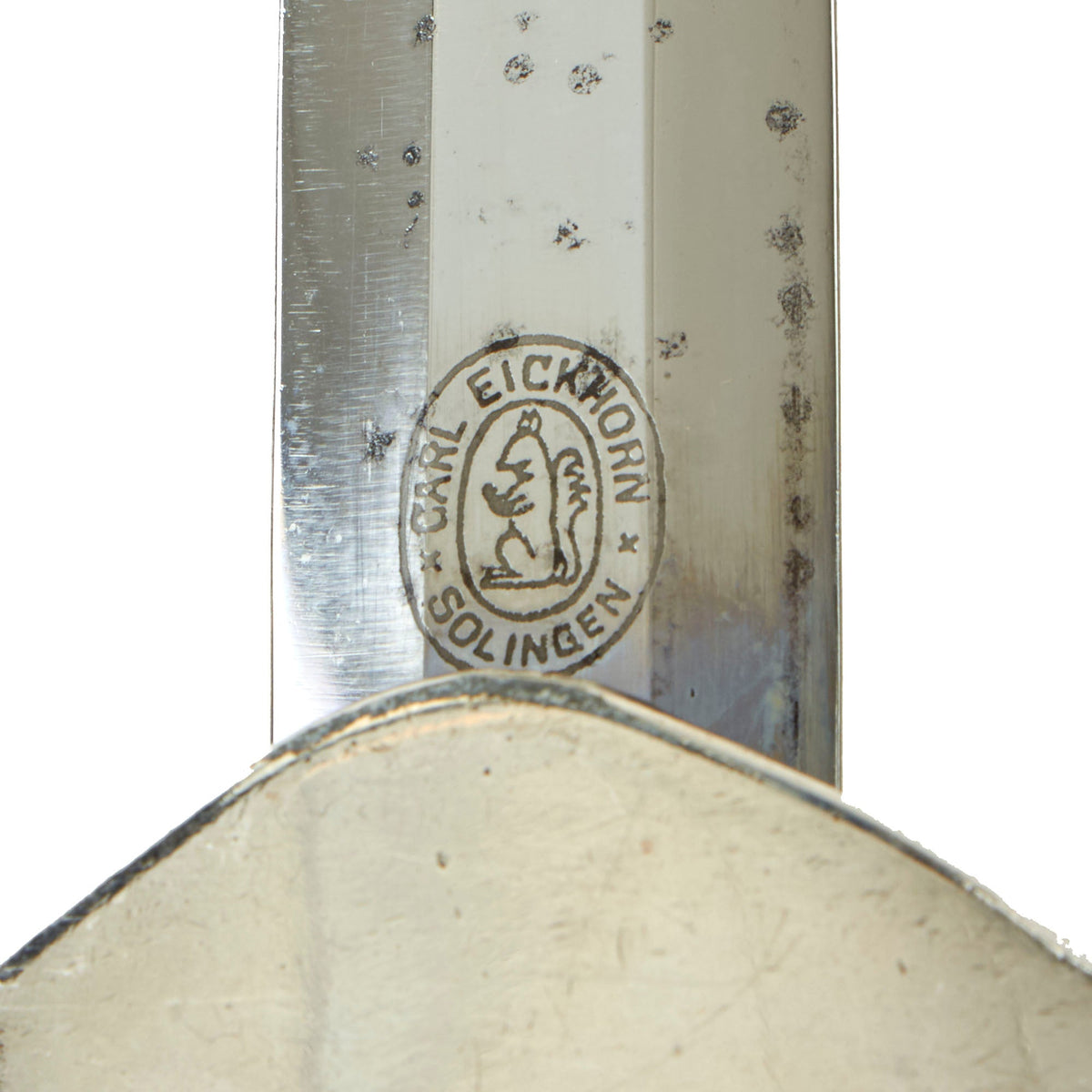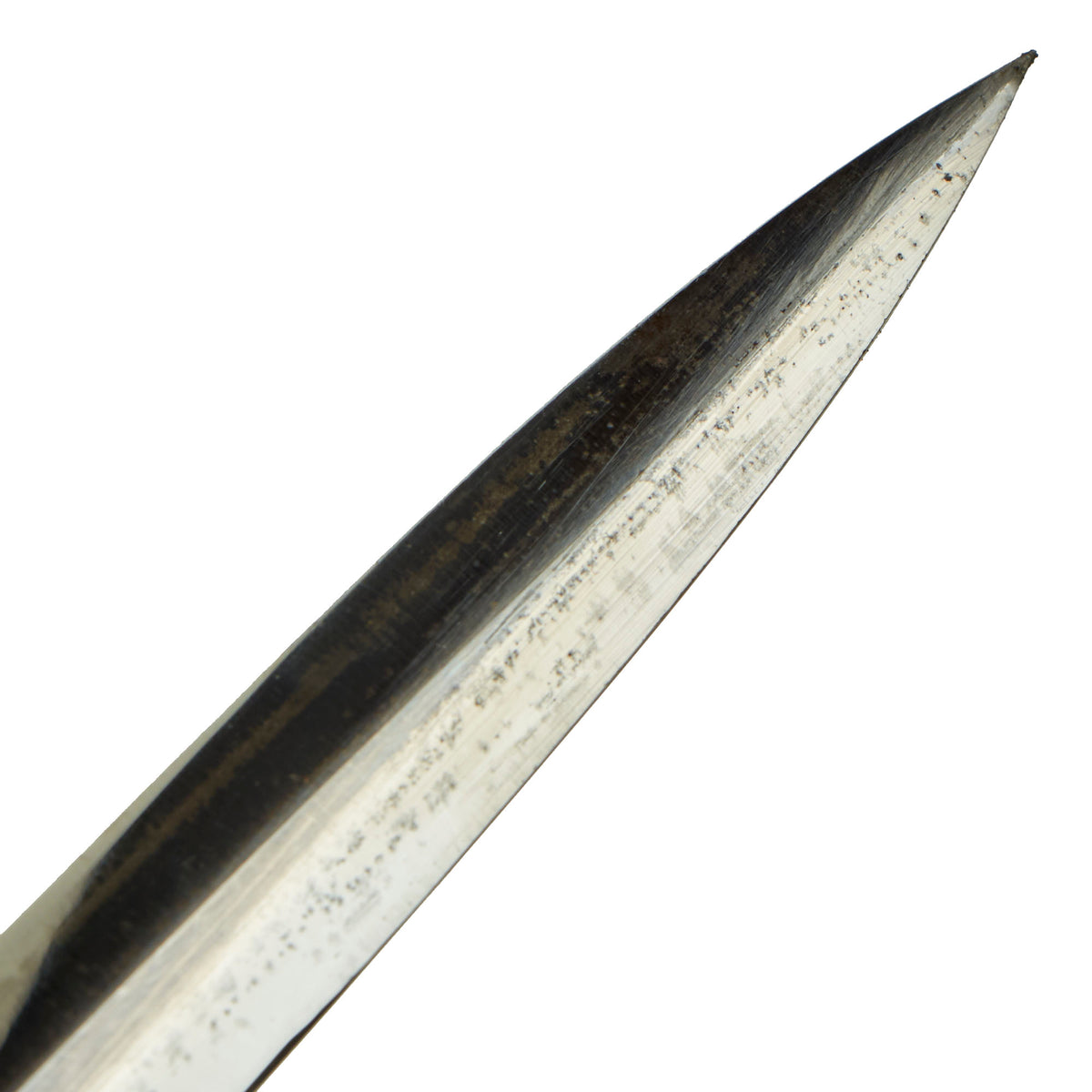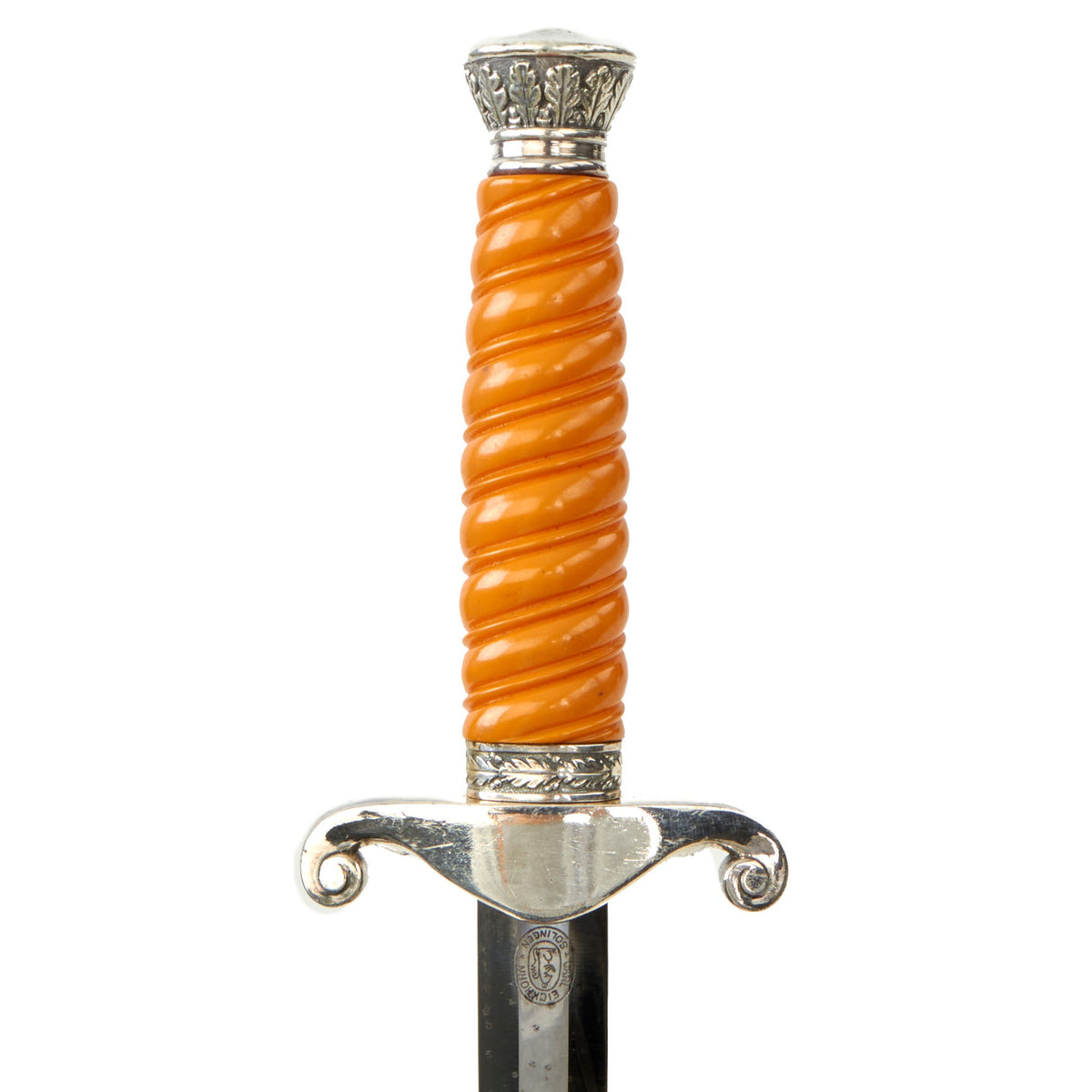Original German WWII Early Army Heer Officer Dagger by Carl Eickhorn with Scabbard – 1933-35 Trademark Original Items
$ 795,00 $ 238,50
Original Item: Only One Available. This is a very good condition Army Officer’s Dagger, produced by the legendary Solingen-based firm Carl Eickhorn. The alloy pommel of this dagger is in very good condition, showing moderate wear with much of the original plating still intact and bright from polishing. We do not see any plating wear through, even in the scratches, which raises the possibility that the fittings are made from solid alloy like Tombak or Nickel Silver. The standing oak leaves and acorns are crisply detailed and have good darkened backgrounds, which really stand out against the bright raised portions.
The plated crossguard is in similar condition, showing some wear but also bright and shiny, made from the same type of alloy. The details throughout the characteristic eagle are exceptional throughout the head, breast and wing feathering, talons and wreathed mobile swas. The plated steel grip ferrule looks great, bright with antiquing between the oak leaves. The celluloid grip has faded a nice aged caramel orange color, and is in great condition throughout, showing very little wear and no cracking or other damage. There is no staining or dirt in the grooves of the design, so it was probably cleaned somewhat recently.
The blade on this example is in very good condition, with some scattered light oxidation staining, and light wear from cleaning and the scabbard runners. The factory final polish grind cross grain is present throughout the blade, and can be seen in the light. This texture is iconic, and is the definitive identifying characteristic for a real WWII German Blade. The needle-like tip is still intact, with no bending, and the edge is still nice, with no chips or sharpening. This is definitely a very nice blade, with just a bit of staining, and the cross grain a bit faint due to cleaning.
The rear of the blade is clearly etched with the Eickhorn trademark “losenge” logo: a double oval surrounding a seated squirrel holding a sword, with CARL EICKHORN / SOLINGEN surrounding the squirrel trademark. Carl Eickhorn is a legendary maker from Solingen, the famous “City of Blades” in Western Germany.
According to J. Anthony Carter’s book, GERMAN KNIFE AND SWORD MAKERS, this company was founded in 1865 by Carl Eickhorn, and is arguably the most famous of all Solingen makers. Not only could the family trace their history back 500 years, but they could also demonstrate involvement in the hardening and grinding industries for the same period. Truly the nobility of Solingen Edged weapon dynasties. Eickhorn edged weapons are the most desirable of all makers. The original leather blade buffer is in place within the recesses of the guard.
The scabbard is a fine example, and is made of high quality plated steel. It does show some denting on the exterior side towards the bottom, but this does not interfere with sheathing the blade. This scabbard has very crisp, finely pebble grained panels, and the carrying bands have a very nice overlapping oak and acorn motif, a common design seen on German edged weapons. The throat is the thinner style, and has a single flush securing screw on the rear of the scabbard. The finish looks to be silver or nickel, and is still well retained, with some areas of plating loss that have oxidized. In these areas the plating has flaked and bubbled away, which is common on nickel plated examples.
A lovely example from the most legendary of all Solingen makers, complete with scabbard. Ready to display!
Specifications:
Blade Length: 9 1/2″
Blade Style: Spear Point Dagger
Overall length: 14“
Crossguard: 2 3/4”
Scabbard Length: 11 1/8″
The German Army (Heer) first carried a dagger beginning in 1935. The weapon was worn in lieu of occasions not demanding the wearing of a more formal sword. The dagger design was quite attractive featuring silvered heavy fittings with white or colored grip. The crossguard depicted a Wehrmacht open-winged eagle clutching a wreathed swas.
The pommel depicted oak leafing around the outer circumference. The scabbard had panels of pebble designs. Later produced examples were plated with nickel, and late war-made pieces were unplated, finished in a gray color metal. This early war version is quite nice, and in great shape.
Fast Shipping with Professional Packaging
Thanks to our longstanding association with UPS FedEx DHL, and other major international carriers, we are able to provide a range of shipping options. Our warehouse staff is expertly trained and will wrap your products according to our exact and precise specifications. Prior to shipping, your goods will be thoroughly examined and securely secured. We ship to thousands clients each day across multiple countries. This shows how we're dedicated to be the largest retailer on the internet. Warehouses and distribution centres can be located throughout Europe as well as the USA.
Note: Orders with more than one item will be assigned a processing date depending on the item.
Before shipping before shipping, we'll conduct a thorough inspection of the items you have ordered. Today, the majority of orders will be delivered within 48 hours. The delivery time will be between 3-7 days.
Returns
The stock is dynamic and we cannot completely manage it because multiple stakeholders are involved, including our factory and warehouse. So the actual stock may alter at any time. It's possible that you may not receive your order once the order has been made.
Our policy is valid for a period of 30 days. If you don't receive the product within 30 days, we are not able to issue a refund or an exchange.
You can only return an item if it is unused and in the same state as the day you received it. You must have the item in its original packaging.
Related products
Uncategorized
Uncategorized
Uncategorized
Uncategorized
Australian WWII Owen MK1 Machine Carbine SMG Custom Fabricated Replica with Sling Original Items
Uncategorized
Uncategorized
Armoured Fighting Vehicles of the World: AFVs of World War One (Hardcover Book) New Made Items
Uncategorized
Uncategorized
Band of Brothers ORIGINAL GERMAN WWII Le. F.H. 18 10.5cm ARTILLERY PIECE Original Items
Uncategorized
Uncategorized
Uncategorized
Armored Burgonet Helmet & Polearm from Scottish Castle Leith Hall Circa 1700 Original Items
Uncategorized
Uncategorized
Uncategorized
Uncategorized
Uncategorized
Uncategorized
Uncategorized
